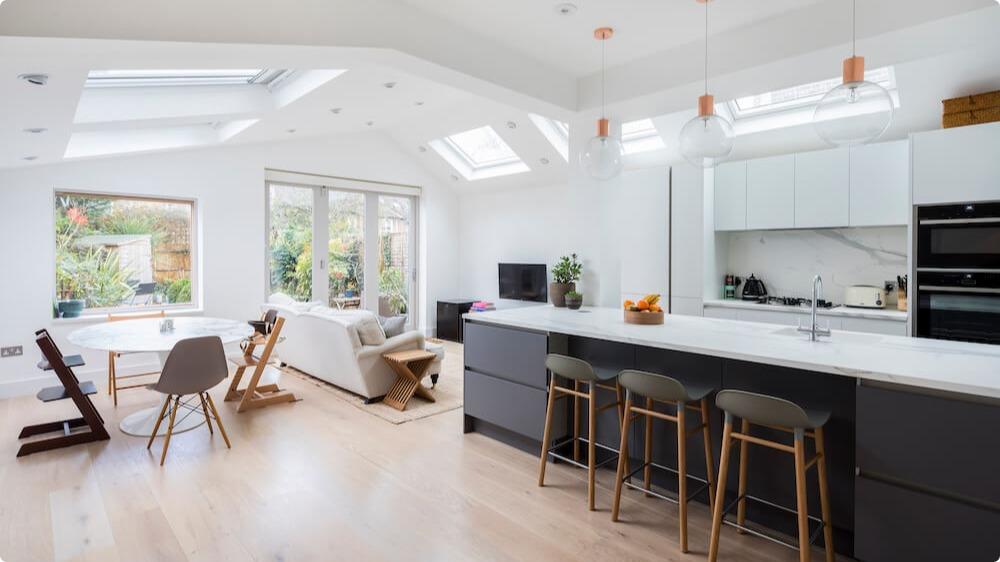Blue: A calming colour that makes you feel centred, relaxed and serene, blue is known to help lower blood pressure, clear the mind and help steady breathing.
Yellow: Brightening th
e mood of a room, yellow is thought to increase energy and create positive vibes.
White: Creating a spacious and cleansing feel, white is an ideal colour for a home office, kitchen, or art studio. Less distracting than other colours, white ignites a fresh feeling, both mentally and physically.
Green: Symbolising prosperity, green is a great colour for your home office. Oddly enough, green is also known to be restorative, mind-clearing and encouraging, and is said to be one of the most restful colours for your eyes.
Purple: A rich, dramatic colour, historically the colour of royalty and luxury, deep purples give off a very romantic, mysterious and luxurious vibe and are great for sparking creativity.
Orange: An exciting colour that brings a burst of energy and enthusiasm to a space, orange is increasing in popularity for exercise rooms.
Red: Traditionally linked to romance, red is also linked to hostility and rage, and is known to raise blood pressure, heartbeat and irritability. Be wary when adding this shade to any areas made for relaxation.
Pink: Having the opposite effect of its primary colour, red, pink has been said to have a calming and soothing effect. Traditionally known for its use in baby girl nurseries, this light airy hue is now all-grown-up, appearing in rooms throughout the home. Coined, the “Pink Effect,” for its peace-inducing vibe, this subtle shade works well in all garden rooms.
Earth tones: Colouring your interior doesn’t always mean adding colour. Letting the natural tones of the home’s furnishings, floors and walls set the tone of the room can create a peaceful vibe.
Earthy walls in brown and green, and furniture carved from nature, colour garden rooms with calm and a sense of tranquillity.
Once you find a scheme you like, limit the number of colours in a room to a select few as too many create a chaotic mood.
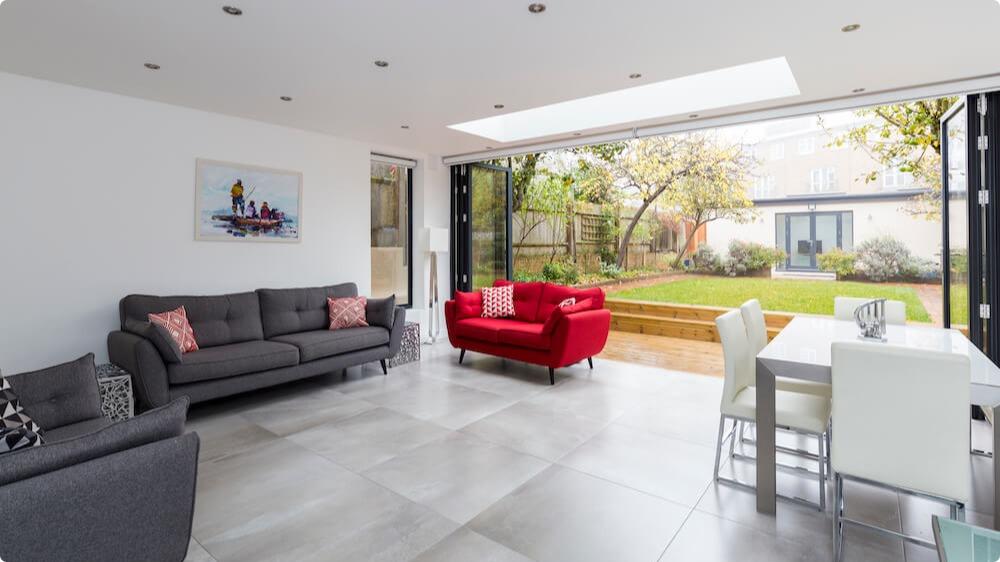
Lighting options for a garden room
Often viewed as a purely functional component in a room, choosing the right lighting sets the vibe and tone to a space.
Natural lighting: Natural light has many benefits for both the ambience of your room and your well-being. Natural light is proven to increase productivity and can be a great alternative to the harsh artificial lights commonly found in office settings.
One of the many benefits of working in a garden home office, natural light has been found to relieve stress, creating a calm work environment.
Skylights: To add natural light to your garden room, why not consider installing skylights, which add ambience and a sense of luxury. Sun pipes, roof windows and skylights are perfect aesthetic and functional solutions for garden studios, greenhouses, and multipurpose rooms.
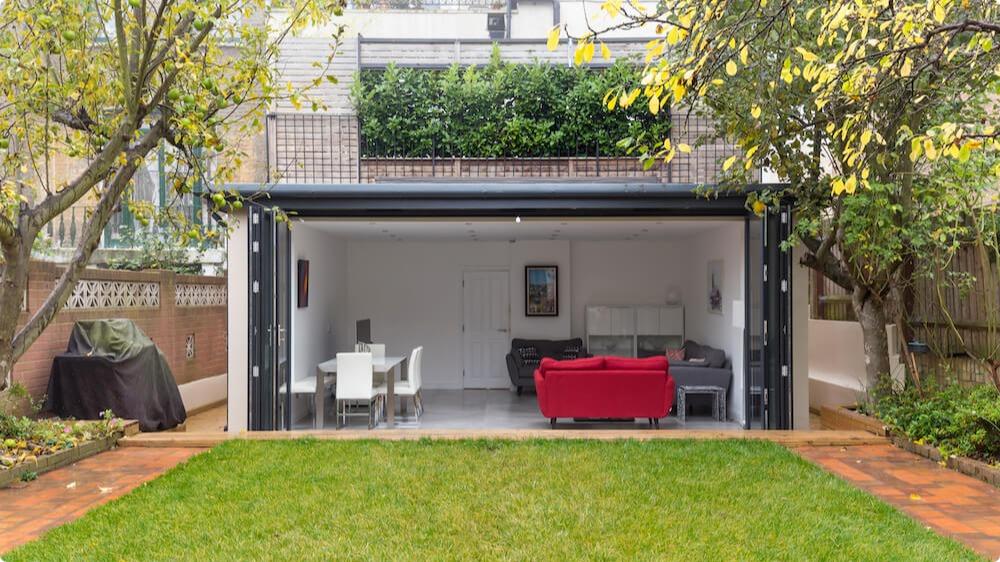
Ambient lighting: Creating a tranquil ambience with clever lighting is important if you plan to use your garden room as a yoga studio, meditation room or home theatre.
Lamps: Useful for adding light to dark corners or a naturally lit room, and a must-have for a garden home office or art studio, desk lamps add targeted light for improved focus.
LED strip lighting: One of the most energy-efficient and easiest lighting solutions of all, and generally not requiring professional installation, LED strip lighting can really brighten up a room. And because they do not output heat, these stip lights are also extremely safe and eco-friendly.
Decorative lighting: Not all lighting fixtures need to be purely functional. Decorative lighting can kill two birds with one stone, by bringing both illumination and style. Popular options include stylish pendant lights or freestanding fixtures.
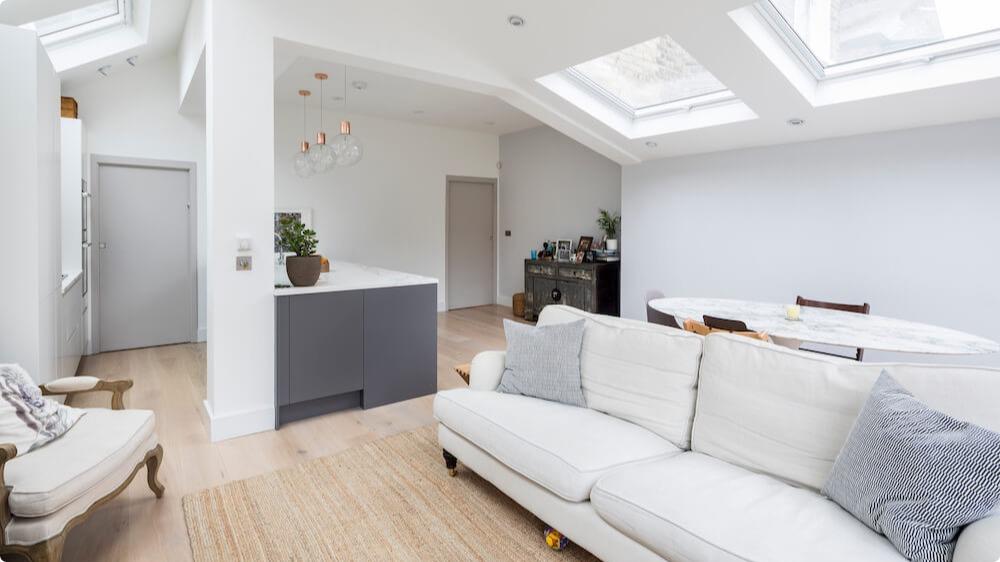
Flooring
Style is essential when considering your garden room flooring, but there are other factors that should also be considered, including material and labour costs, maintenance, durability, and comfort. While flooring options are practically endless, wood and stone have been some of the most popular additions in recent years.
Benefits of stone flooring
- Aesthetically connects the natural surroundings with the indoors
- Far more durable than wood
- Timeless
- Insulated
- Easy to keep clean
Benefits of wooden flooring
- Less expensive than stone
- Hardwood floors can still be durable
- Comfortable on the feet
- Warmer than stone
- Easy to clean
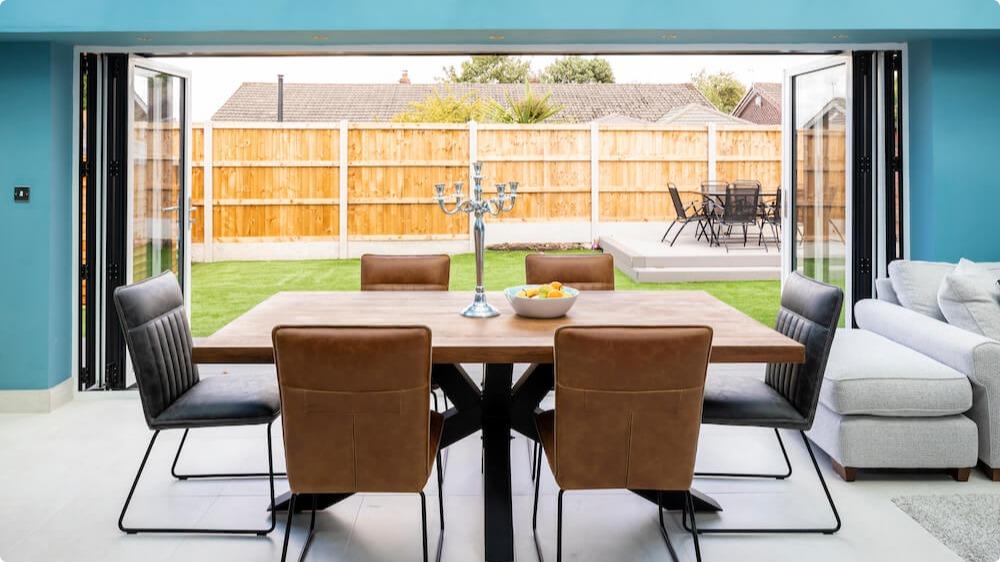
Indoor garden room furniture
A garden room provides more than just a functional space. It is another living area that can be furnished to suit your personal style. A garden room is an extension of your home and, as such, should be filled with comfortable furniture and decorated with your favourite things.
Rustic & shabby chic: Shabby Chic furniture adds a rustic, natural and fresh appeal to your garden room. Choosing vintage or upcycled furniture is a cost-saving and design-inspired way to freshen up your garden room.
Modern & minimalist: For a more sleek and stylish look, less is more. Go for simple furniture, made from industrial or natural materials, or blend the two.
Healthy chic: If you are planning to use your garden room as a yoga studio, consider furnishing your space with minimalist pieces and natural materials, such as rattan lanterns, scatter cushions, bamboo shelves and wicker baskets. The natural tones will help create a peaceful and grounded environment.
Spacious comfort: A garden room makes the perfect setting for hosting parties, holiday dinners and barbeques. Furnishings for rooms used for entertaining require ample seating for guests. Sofas, accent chairs and side tables are also must-haves for rooms that will accommodate gatherings.

Outdoor garden room furniture
Outdoor areas should be as unique as the structures they grace. Depending on the style of your garden room, outdoor furnishings can be anything from vintage to modern; rustic to botanical.
No matter what the style, outdoor furnishings should complement your interior design.
Rustic: Whether your garden room is modern or traditional, you can never go wrong with rustic furniture. Two of the most popular styles are cabin log style or even adirondack.
Modern: If your garden room décor reflects modern style, outdoor furniture with similar design features will pull your outdoor and indoor areas together. Choose from aluminium, steel and wooden materials and the clean lines of contemporary designs.
Casual Tuscan: Tuscan outdoor furniture is a no-frills look, perfect for casual dining and relaxing off of an equally casual garden room. A long harvest-style table with simple chairs would serve as a centrepiece for large family gatherings. Comfortable cushions, deep-seated chairs, and occasional tables add rustic charm.
Cottage/Shabby chic: Nothing says cottage more than wicker furniture. Pick up great vintage pieces from flea markets and garage sales. To go shabby on a dime, a simple can of spray paint can create a cottage style that plays off the colours of your garden or a shabby chic room.
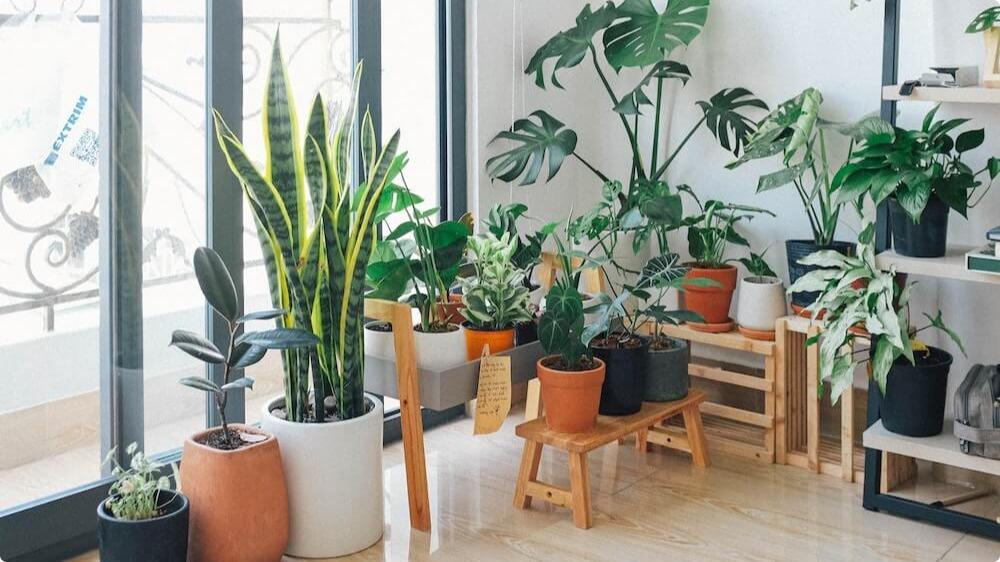
Fill your garden room with plants
One of the easiest ways to add a natural design aesthetic to a garden room is plants. Houseplants come in all shapes, sizes and, yes, styles, so choose varieties that not only speak to your aesthetic taste, but complement your lifestyle and fit into the room’s environment.
When closing plants for your garden room, consider these factors:
Environment: First and foremost, choose plants that will thrive in your space. Many people buy plants strictly for aesthetic reasons, but so much of plant styling is about the environmental conditions. Assess the room’s natural lighting, temperature and humidity levels before heading to the nursery.
Lifestyle: Many plants thrive with infrequent watering and feeding, while others require constant attention. It’s important to be honest with your green thumb abilities before digging into plant care.
Design harmony between interior and exterior
To feel comfortable in a space, harmony is essential. Without it, we can never truly relax. Creating a harmonious balance between interior and exterior design in a garden room setting is essential.
Botanicals: Plants are a no-brainer way to create fluidity between the two spaces. Consider adding an abundance of plants near the doorway to your outdoor space and slowly taper them as you get further into the interior.
Glazing: Windows that extend from floor to ceiling, and on the ceiling above, create a garden room that seamlessly blends with the exterior landscape.
Canopies: Extending your roof over your patio or garden allows you to keep your doors open to let in the sounds and breeze of the outdoors, even when it’s raining, and creates continuity to the spaces.
Flooring: Your floor is literally and figuratively your design’s foundation, so it’s a great place to start. Installing the same flooring in the interior as your exterior space is one way to create a harmonious flow between the two spaces. Tile and concrete are great materials for a garden room as they withstand the outdoor elements.
Light: Just as floors connect the two spaces, lighting provides fluidity between the two spaces. Skylights and large windows maximise indoor/outdoor harmony and give the space a light and airy feel.
Letting there be light on the exterior as well keeps continuity flowing when the sun goes down. Merge the two spaces by installing plenty of light sources on the exterior of your garden room.
Furnishings: While you typically don’t want to use the same furniture in your indoor and outdoor spaces, you can use similar styles and hues to create harmony between the two spaces. Rattan and wicker outdoor sofas and chairs can be reimagined indoors with the use of tables, baskets and poofs made from the same material and colour.
Materials: Incorporating materials traditionally meant for the outdoors in your interior–and vice versa–creates an instant visual connection between the two spaces.
Exposed brick walls, feature wood panelled walls and stone floors add harmony between the spaces. As such, adding soft touches to the outdoor space, using traditionally interior components like pillows and throws, provide a harmonious effect.
Dining or sofa outside: Adding a dining space outside of a garden kitchen creates a natural flow for guests to travel between the two spaces. Creating a seating area outside achieves a similarly harmonious connection.

Do you need an interior designer?
Design is the perfect balance between functionality and beauty. Interior designers get to know you, your lifestyle, and your taste.
If you do not have the time, patience or creative motivation to do it yourself, and it fits into your budget, hiring an interior designer will yield impressive results. But if you have a passion for decorating and have the time, designing your garden room yourself is cost-effective and gratifying.
How much does an interior designer cost?
When it comes to interior design fees, there is no set standard. Aside from the materials, which can greatly determine the end cost, there are also different types of interior design fees.
Percentage fee structure: Some designers charge by the hour with a rate ranging between £100 to £400 an hour. Other designers will charge a percentage rate for the total cost of a project, which is as low as 10% and as high as 25%.
Hourly fee structure: Similar to that of other contractors, there is the classic flat hourly fee structure where a designer bills the entire project based on an hourly rate. The average price for a principal designer is around £250, but the gap can range anywhere from £100-£400.
Flat rate fee structure: The fee structure with the most transparency, a flat fee structure, requires the most upfront legwork, as a project has to be adequately assessed ahead of time. This often involves a set number of design meeting hours with a limitation on revisions.
Getting ready to start work on your garden room extension? Talk to a Resi design expert today for a cost estimate and free architectural quote.
